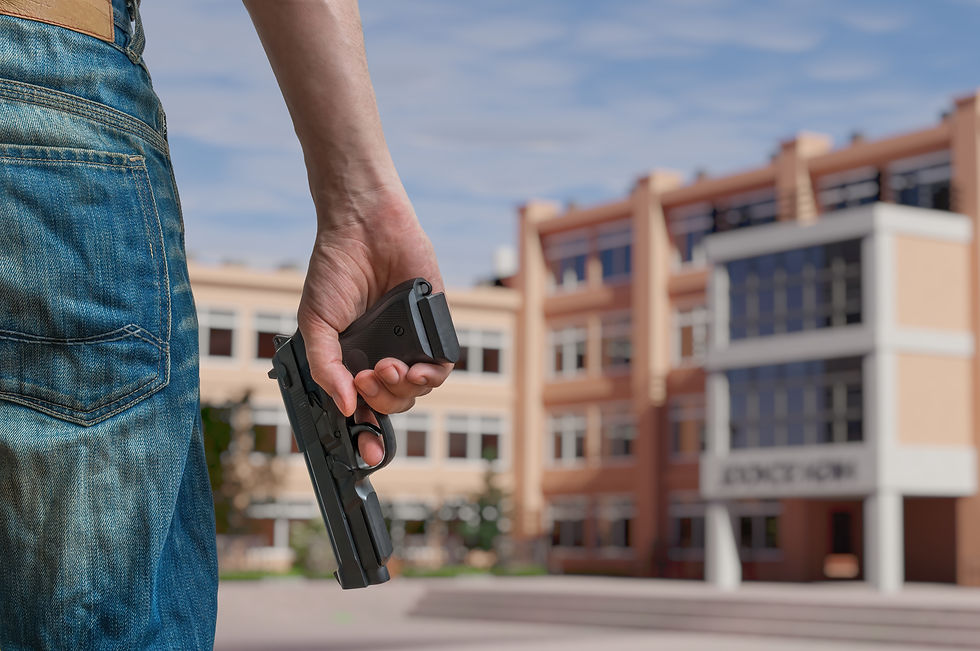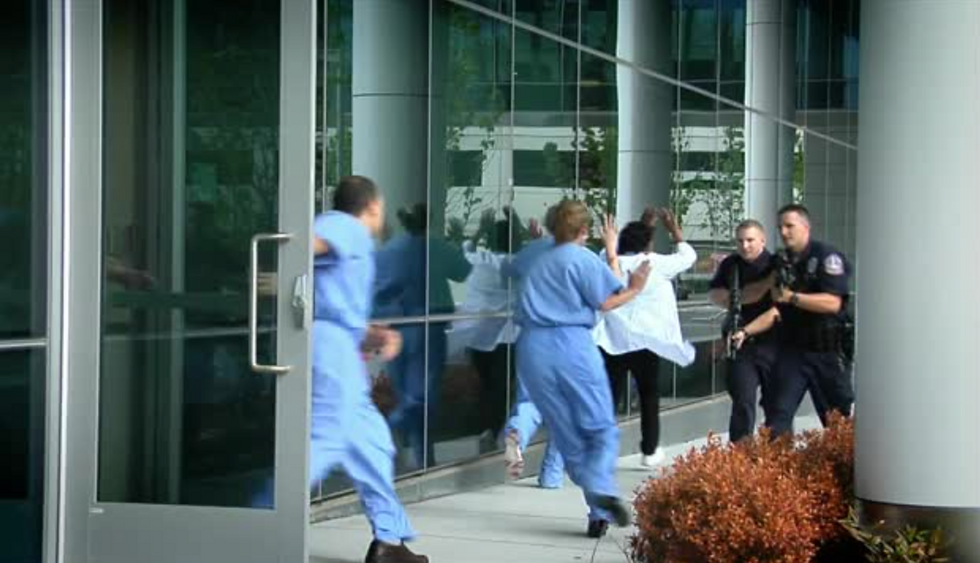CPTED AND ACTIVE SHOOTER PREVENTION
- GENE PETRINO

- Apr 2, 2020
- 5 min read

The increase in Active Shooter Incidents has brought critical attention to the need to bolster the physical security of our schools, houses of worship, and businesses. Statistically, you have a very slim chance ever being involved in such a horrific incident. However, the impact of these events far exceeds those statistics. These are heinous and devastating crimes. We must all work together to find solutions to a very complex issue. Sadly, it always comes down to money and bureaucratic red tape. That is a suffocating combination. The good news is that there are affordable solutions that don’t always have huge financial impact. Furthermore, they are common sense and usually cut through the red tape quickly. The impact of these incidents can be greatly reduced by improving the design of our most vulnerable locations. This concept isn’t new; however, it hasn’t been completely embraced in our country. Let’s examine Crime Prevention Through Environmental Design (CPTED) and how can combining it with target hardening techniques can help us reduce violence.
CRIME PREVENTION THROUGH ENVIRONMENTAL DESIGN (CPTED):
Crime Prevention Through Environmental Design (CPTED) is defined as a multi-disciplinary approach for reducing crime through urban and environmental design and the management and use of built environments. Experts in the fields of Law Enforcement, Architects, property owners, Code Enforcement, and community leaders contribute recommendations to enhance the natural settings to reduce unwanted behavior. The strategies in CPTED aim to build a sense of community among inhabitants so that they can gain territorial control of areas, decrease victimization, and reduce opportunities for crime, both real and perceived. All of this is accomplished by focusing on four specific areas: Natural Surveillance, Natural Access Control, Territorial Reinforcements, and Maintenance.
Natural Surveillance and Natural Access Control are strategies used to limit the opportunities for criminal behavior. Let’s examine each one to see how it can positively impact active shooter incidents.
NATURAL SURVEILLANCE:
Natural Surveillance is used to increase the visibility of people’s activities in all areas of a location. This is because it is a fact that criminals will be less likely to commit a crime where they can be seen by others. For example, you are more likely to be robbed in a dark alley than you are in an open, well-lit sidewalk that can be seen by others. To achieve this, CPTED focus on several areas which are often overlooked by owners.
Keeping windows unobstructed to provide a clear view of the walkways and parking lot. This allows insiders to see approaching threats enabling them earlier notification to first responders and security personnel
Increasing the width walkways to encourage more foot traffic. More people around decrease the likelihood of criminal activity
Utilize fencing that doesn’t obscure direct sight ie. wrought iron, etc. {PIC}
Use lighting that provides sufficient coverage without causing glare
Eliminate ambush points in areas most vulnerable. For example, open stairwells with see though stairs Insert {PIC}
NATURAL ACCESS CONTROL:
Natural Access Control help define areas between public, semi-private, and private. It controls movement so that anyone that is not supposed to be in a specific area can be observed immediately.
Utilized landscaping to define areas and direct pedestrian movement. Landscaping can also be used to prevent access to areas by way of planting thorny bushes and plant in front of windows or on walls
Eliminate access to roof tops or upper levels that can be used as a high ground for assailants
Use self-locking doors and gates
Using traffic calming devices to slow and restrict vehicle movement. Ie. Curved entries, speed bumps, and round abouts
Have a clearly marked single entry to the building to control access. This is also known as a celebrated entry {PIC}
Place vulnerable areas such as bathrooms and locker rooms in heavily populated areas
TERRITORIAL REINFORCEMENTS:
Territorial reinforcements improve social control by clearly identifying space. This also creates a sense of ownership by way of using focal points. Ie. Fountains, murals, statues, etc. When there is a sense of ownership, people are more likely to observe intruders and either confront them or notify security. Territorial reinforcements are designed to make the normal user feel safe and the abnormal user feel exposed.
Create natural gather points such as public benches and seating areas to promote natural surveillance
Display signage for direction as well as notification of security measures in place
Provide well-lit paths and walkways which are unobstructed by landscaping
MAINTENANCE:
There is no better expression of ownership than proper maintenance. This ties in with the Broken Windows Theory {https://en.wikipedia.org/wiki/Broken_windows_theory}. The broken windows theory is a criminology theory that states visible signs of crime, anti-social behavior, and civil disorder create an environment that promotes further criminal activity. CPTED falls right in line with this concept. Overgrown landscaping, graffiti on buildings, and dilapidated fencing creates an environment conducive to crime.
COST:
CPTED is ideally part of the design phase of a new construction project. That provides the least financial impact and only a nominal amount of time to the review process. In most cases, however, CPTED is more likely needed to existing structures and campuses. This does not mean it costs more or is not feasible. In fact, some of the recommendations may even save money. Take lighting for example. Most commercial complexes and even schools have high cost lighting. Replacing them with newer LED lighting will not only provide better visibility, it will save money in energy costs. Additionally, there is likely be savings in reduced insurance claims due to criminal activity.
As with all CPTED reviews, the examiner will make recommendations. As such, it is up to the property owner/manager to determine the scope and costs of the upgrades. Either way, it is a great starting point in securing our vulnerable sites.
TARGET HARDENING & PHYSICAL SECURITY MEASURES:
Perhaps the most important feature in securing a location is access control. Limiting the entry is the single most effective way to prevent unwanted persons from carrying out malicious acts. When considering access control measures, there are two areas you should first focus on. First, vehicle access should be restricted where possible. The second area is structure access.
VEHICLE ACCESS:
There are many options available for assist in vehicle access control. The most critical element to vehicle access is main entrance. Every location should have a clearly marked entry so that new comers will know exactly where they should be going. This prevents visitors from driving into restricted areas. In CPTED terms, this is known as a celebrated entry. This can be achieved by landmarks such as fountains or statutes; architectural designs such as overhangs and elevation variations; signage; pathway markings; or any combination of the above.
For locations that require drop offs, such as schools, daycares, or healthcare facilities, clearly marked drop off zones, round-abouts, and single directional lanes can help keep traffic flowing smoothly. These components also help identify potential vehicular threats early on. Bollards can also provide additional security to prevent vehicle from either accidentally or intentionally driving into the structure.
For locations which are primarily employee only structures, gate and fencing options are best.
Finally, despite the location use, make sure that there is sufficient lighting to provide nighttime security.
VISUAL SURVEILLANCE:
Video surveillance has become a staple for family homes to multimillion-dollar businesses. With their rising popularity, the cost per unit has dropped dramatically while the quality has increased exponentially.







Comments